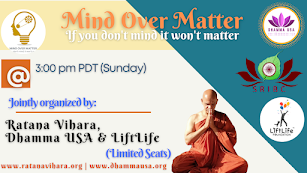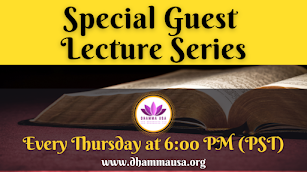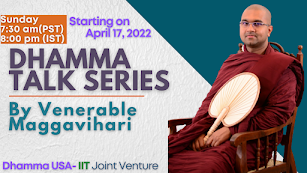Kaṭhiṇa Robe Offering Ceremony - History and Development
 Meaning of Kaṭhiṇa
Meaning of Kaṭhiṇa
Rough, hard, stiff, difficult, durable. The Pali-English Dictionary of Venerable Buddhadatta also mentions ‘the cloth annually supplied to the monks for making robes.’
Mahāvagga Pāli of the Vinaya Piṭaka mentions that Kaṭhiṇa robe offering is the most meritorious act of skillful deeds with immeasurable merits.
Four Requisites
cīvara - robe
piṇḍapāta - food
senāsana - dwelling
gilānapaccaya – medicine
are the four basic requirements for a Buddhist monk.
Eight Great Wholesome Deeds (Aṭṭḥa Mahā Kusala Kammāni)
There are eight wholesome deeds as have been maintained by the popular tradition.
Kaṭhiṇaṭṭhaparikkhāraṃ
Vāsadānaṃ ca uttamaṃ
Buddhappamukha saṅghassa
Dānaṃ dhammassa lekhanaṃ
Khetta dānaṃ ca buddhassa
Paṭimā karaṇaṃ pi ca
Karaṃaṃ vaccakuṭiyā
Aṭṭha puṅṅāni vuccare

- offering of Kaṭhiṇa robe
- offering of Eight Requisites
- offering of noble Residential places
- offering of meal to the Buddha and the Saṅgha
- offering of Dhamma text writing
- offering of paddy fields to the Buddha
- offering of Buddha Statue making
- offering of rest-rooms
The Buddhist community is committed to fulfil these noble meritorious acts in their capacity to help preserve the Buddha sāsana along with their spiritual leaders called bhikkhus (monks).
History of This Unique Tradition

According to Vinaya Piṭaka which represents the Code of Moral Conduct for Buddhist monks and nuns, during the Buddha's time, the monks have been advised by the Buddha, to wander forth for the benefit of the many including humans, deities and all other sentient beings. Hence, the monks kept traveling from one place to another helping the community in many different ways teaching the noble message of their spiritual master. Unlike in California today, it rains in India during the monsoon season and when it rains it rains with gust of winds and the downpours can be quite heavy. But the monks kept traveling as they have been advised by the Buddha to do so even during this hard time. Having seeing the monks traveling during the rainy season especially walking on the beautiful green meadows, the other religious communities started accusing them of killing the mono-organ grass which was supposed to be a life according to them. Traveling during the rainy season was particularly not a very pleasant experience for monks due to many reasons. When the Buddha heard of this situation, he made a wonderful decision to allow the monks to use this opportunity completely focus on their own spiritual achievement. The Buddha asked the monks to observe rains retreat during which they are supposed to stay in one place practicing with sheer determination to achieve their own spiritual goals.
Anujānāmi bhikkhave vassāne vassaṃ upagantuṃ.
(I recommend you monks to observe the rains retreat during the rainy season.) –
Vinaya Piṭaka, Vassūpanāyikakkhandha
Hence, the monks started adjusting to the new culture by selecting a suitable place for their spiritual practice. Most of them would go to a remote jungle area to practice but also trying to stay somewhat closer to the human settlements in order to survive themselves with alms round for food. They would observe something called Sattāhakaraṇīya (satikaraṇa) meaning they are supposed to return to their original place of rains retreat observation just in case they had to leave for some other place due to some reason.
sace me koci antarāyo na bhaveyya, sattāhabbhantare puna nivattissāṃi.
(I will return back to (this place) just in case I don't meet any life-threatening situation.)

Then they would observe the rains retreat in a small simple kuṭi (hut) provided to them by the lay devotees or by themselves, in a cave or in any other safer place such as a root of a comfortable tree or a rock etc. They determined themselves to observe the rains retreat as regular mundane monks wanting to achieve arahantahood before the end of the rains retreat. Then they would practice day and night completely engrossed in the practice of meditation for the entire rains retreat. There are numerous stories about these monks achieving perfect liberation (Nibbāṇa) during the three months' period and hundred and thousands of them would visit the Buddha as arahantas to pay respect to their master. The devotees would also take good care of these practicing monks during this period and they themselves gained lot of merits in the process. Some even started to follow the spiritual path using the opportunity of seeing the monks practicing with sheer determination. At the end of the retreat, the lay devotees would offer them a robe and it was called Kaṭhiṇa robe with some special benefits and privileges compared to the other robes. It is a very unique opportunity for the lay people to offer a Kaṭhiṇa robe to such a powerful and determined monk and no wonder they would receive more merits in return. When doing so, the lay devotees also would observe eight precepts or ten precepts to help themselves proceed at least to a certain extent in their spiritual journey while engaging in their secular day-to-day activities such as cultivation and other professions.

The robe offering was a very powerful merit because the monks those days used to wear any ragged clothe picked from the cemeteries, streets, rubbish heap etc. and putting those worn-out pieces of clothes together. They would dye this clothe using natural herbal colorings extracted from jack trees and many other trees, roots, barks from different plants. This process also helped their clothe to take a unique color and sanitized naturally from any prospective germs when they would pick the clothe from different places. Finding a piece of clothe was not so easy those days and offering a robe to such a spiritual practitioner would naturally be very meaningful as well. Hence, the Kaṭhiṇa robe offering became a very popular among the folks in the course of time. That was the tradition of the sewing and dying process of the robe which has taken many different shapes today.
Rains Retreat – is a symbolic representation of sheer determination, firmness and stability on the spiritual path. Both the practitioners and the sponsors can receive immeasurable merits due to the powerful spiritual energy associated with the process in the three months.
Some Important Rules Pertaining to the Kaṭhiṇa Robe
 ·
· Only those who successfully complete three months of Vassāna (rains retreat) can accept the Kaṭhiṇa Robe
· Offering of Kaṭhiṇa Robe should be done in the month called Pavāraṇa (conclusion) which falls in between September-October or October-November (Lunar Month) which is also called Assayuja – Kattikā in Pāli.
· Lay people offer the Kaṭhiṇa robe and a group of at least four monks officially hand over the Kaṭhiṇa robe to a selected monk with everyone’s approval.
· That monk can no longer receive any other Kaṭhiṇa robe during that month.
· Later observers (Pacchimikā) cannot receive a Kaṭhiṇa robe.
· Only early observers (Purimikā) can receive the Kaṭhiṇa robe.
· Proper time is prescribed as from sunrise to the dawn. (24 hours)
Five Privileges of the Kaṭhiṇa Robe Receiver
o Free to go to meal invitation without having informed to another monk
o Usually monks have to carry a full set of three robes wherever he travels. But the monk who receives the Kaṭhiṇa robe is allowed to go without the full set of three robes for a specific time period.
o He can enjoy a group meal with four or more monks.
o He can use as many robes.
o He can receive other robes offered to the Saṅgha during the rains retreat and on the Kaṭhiṇa robe offering day.
Kaṭhiṇa Robe Offering Today

The three-month rain retreat (rain in California can never be compared to the torrential rains in Asian countries) of the Buddhist monks conclude with the Pavāraṇa (Conclusion) ceremony, which is ceremoniously celebrated by the offering of Kaṭhiṇa Robe to the resident monks of the particular temple. Kaṭhiṇa robe offering can be done only once a year in a temple and only one monk can receive the robe which will be determined by the monks assembly on the Kaṭhiṇa Day. In the West, it is even unique as all the Saṅgha members get together in doing so as against the traditional sectarian units in the traditional Buddhist countries.

In modern day Theravāda Buddhist countries, Kaṭhiṇa Robe Offering ceremony is among the topmost merit making acts in the Buddhist calendar. It is uniquely celebrated all over the world wherever the Theravāda Buddhist monks reside. Basically, the major Theravāda Buddhist countries include Sri Lanka, Thailand, Myanmar (
Burma), Cambodia, Laos while India, Bangladesh, Nepal, also have significant presence of Theravāda Buddhist population. Besides, with the immigration of Theravāda Buddhists to Europe, America and Australia, New Zealand, Canada etc., the ceremony is celebrated in all these countries today in a beautiful manner with their own cultural identities.
Today’s Kaṭhiṇa ceremonies are marked by large

festival moods along with diverse cultural entertainments. Cultural performances, singing and dancing according to their own traditions have become indispensable part of the annual Kaṭhiṇa robe offering ceremonies. The meritorious acts include delivering Dhamma Talks and regular chanting and conducting meditation retreats by the monks, while the lay devotees have the opportunity to observe five precepts, eight precepts, offering Dāna to the Saṅgha and even to practice meditation in their free time. Usually a lay devotee would invite the monks to observe the Vassāna season (rains retreat) and will serve them during the three months period concluded by the Kaṭhiṇa ceremony. The lay devotee would also announce the Kaṭhiṇa robe offering to the monks and the monks would perform Vinaya rules to dedicate the robe to a designated monk. This merit making event will be concluded by a special Dhamma Talk called Kaṭhiṇānisaṃsa Dhamma Desanā by a senior monk reflecting the benefits of the Kaṭhiṇa robe offering which will be concluded with the sharing of merits to the departed ones and all sentient beings.

In fact, the dominant Theravāda Buddhist countries celebrate this ceremony with more authentic fashion, however, the other countries do not fall behind, and they too celebrate to the best of their ability in their own respective countries. For example, in the West, the Kaṭhiṇa ceremony can be attended by all kinds of people including different schools of Buddhism and not excluding the friends from other religions. Every year, the trend is getting more expansive and the ceremony is becoming more attractive but charming. California, USA can possibly be rated one of the best examples in this regard with over fifteen Sri Lankan temples celebrating this beautiful ceremony with the participation of a large number of Buddhist monks and nuns from both Theravāda and Mahāyāna traditions. Local Buddhist community represented in these ceremonies is not confined to Sri Lankan Buddhists alone. These temples also have a strong presence and affiliation with American, Bangladeshi, Burmese, Chinese, Indian, Thai, Taiwanese and Vietnamese friends (list here is given in alphabetical order). They all work hand in hand with a unique sense of brotherhood. All the monks from these communities attend these awe-inspiring ceremonies in the West today providing a wonderful example of unity in diversity.
How to Make It a Meaningful Kaṭhiṇa?


Kaṭhiṇa is a Buddhist festival which comes at the end of Vassa, the three-month rainy retreat for Theravada Buddhists in Sri Lanka, Bangladesh, Cambodia, Laos, Myanmar, and Thailand etc. It is a time of Dāna (practicing generosity), Sīla (observing moral precepts), Bhāvanā (meditation), for the laity to express gratitude to their spiritual guides, the Buddhist monks). Vassāna season is also very significant for all the Buddhist monks as they have the opportunity to focus more on their spiritual upliftment. Most of the Arahanta monks have appeared in the world during this particular period as the monks determine themselves to attain the spiritual perfection, the supreme bliss of Nibbāṇa during this time. It has a long history of producing more Arahantas than any other time of the year. Hence, the lay devotees too are very enthusiastic in offering something to the Mahā Saṅgha as it makes sense for them to earn more merits by offering something to the worthy ones.
The Story of Venerable Nagita:

There are lot of interesting stories about the Kaṭhiṇa ceremony. Venerable Nāgita's story is foremost among them. Once the Buddha asked 500 Arahanta monks, all of whom were very powerful (catupaṭisambhidā) to attend a special assembly of monks by the Anotatta Lake in the Great Himalayas. Anotatta Lake was not a place for average mundane people to hang around. Only the very specially trained or powerful monks and practitioners could survive in such an extreme cold weather but a uniquely enchanting place. Then the Buddha addressed the monks there asking them to express their reflections upon their own spiritual journey so far because all of those 500 great arahantas were able to read their past lives. Therein those great disciples of the Buddha revealed their spiritual experience one by one including their own saṃsāric (circle of transmigration) journey and their good kammas (actions). It was a very fascinating retreat wherein the 500 arahantas explained their unique good kamma and their relentless efforts to attain the perfect liberation from all sufferings. When it came to venerable Nagita's turn, he explained how he offered a Kaṭhiṇa robe in saṃsāra so many eons ago and how he was benefited ever since in numerous ways. He said ever since he offered a Kaṭhiṇa robe, he was never born in the miserable hell realms and he was always born in blissful heavenly realms even as king of heavens in many times with more divine powers and pleasures. He was always born to good families, happy and healthy and eventually leading to the final realization of Nibbāṇa or arahantahood.

Hence, the Kaṭhiṇa ceremonies always highlight venerable Nagita's story and people try to be complacent by thinking that offering Kaṭhiṇa robe will solve all their saṃsāric myseries and they can live better and happy life in the saṃsāra like venerable Nagita. This is a huge misinterpretation or misreading of Kaṭhiṇa Robe offering and can lead to miserable failures if someone thinks so. To be a part of a Kaṭhiṇa robe offering can surely earn great merits for someone provided he or she acts wisely and the right manner. Preparing oneself to sponsor a Kaṭhiṇa ceremony can be a lifetime opportunity and not everyone can do it as it involves an enormous amount of preparation in many different ways. There are threefold preparations in executing a Buddhist meritorious act, especially an offering of a Dāna:
Pubba cetanā (intention prior to the action)
Muñcana cetanā (intention at the time of execution)
Apara cetanā (intention after the action)
One has to be mentally and physically well prepared for this noble act to make this lifetime opportunity of sponsoring a Kaṭhiṇa robe offering. He or she and the whole family can practice themselves Dāna, Sīla and Bhāvanā to make their life and saṃsāra more meaningful through this wonderful merit making ceremony. Money can be an important factor in sponsoring a Kaṭhiṇa, however, it is the mind that is much more important than anything else. If someone is well prepared both mentally and physically, he or she can surely gain immeasurable merits through this wonderful act since there is a golden opportunity to practice for three months at least. However, this noble act should be extended and strengthened even after the actual three months period is over. That will surely lead he or she to an immeasurable happiness in the saṃsāra and eventually leading him or her to the supreme bliss of Nibbāṇa.
Na ve kadariyā devalokaṃ vajanti
bālā ha ve nappasaṃsanti dānaṃ
dhīro ca dānaṃ anumodamāno
tene'va so hoti sukhī parattha.
"Indeed, misers do not go to the abode of the devas;
fools do not praise charity;
but the wise rejoice in charity and
so gain happiness in the life hereafter."
Sabbe sattā averā hontu
Sabbe sattā abyāpajjā hontu
Sabbe sattā anīghā hontu
Sabbe sattā sukhī attānaṃ pariharantu
May all beings be free from enmity/danger.
May all beings be free from mental suffering.
May all beings be free from physical suffering.
May all beings take care of themselves happily.
May All Beings Be Well & Happy & Healthy!
May All Attain the Supreme Bliss of Nibbāṇa!
Sadhu! Sadhu! Sadhu!
 Bhante Sumitta has been conducting meditation at the Lankarama Buddhist Institute for the past few years and his simple and practical way of meditation has been helping many individuals and groups in the Los Angeles area.
Bhante Sumitta has been conducting meditation at the Lankarama Buddhist Institute for the past few years and his simple and practical way of meditation has been helping many individuals and groups in the Los Angeles area.  He has attended a number of Retreats conducted by very well trained Burmese and other Meditation teachers in different Retreat centers in California, Sri Lanka and India.His teaching and guidance are basically aimed at the introductory level of meditation and practitioners can advance to the next levels of meditation later on with other senior meditation teachers.
He has attended a number of Retreats conducted by very well trained Burmese and other Meditation teachers in different Retreat centers in California, Sri Lanka and India.His teaching and guidance are basically aimed at the introductory level of meditation and practitioners can advance to the next levels of meditation later on with other senior meditation teachers. 






















































































